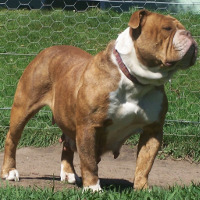Appearance of the Australian Bulldog
|
| A distinct Bulldog type, the Australian Bulldog stands out from similar breeds by being free from anatomical exaggeration. On the front, the muzzle is not as squashed as other breeds, allowing the dog to breathe freely. The Australian Bulldog has a more natural freedom of movement and great ease of motion. The head is broad but streamlined in appearance, with a broad nose that is not too wrinkled. The eyes are round and dark, with an alert, friendly expression. The Australian Bulldog's ears are medium-sized and fold back. The underside of the jaw is level, with ruffles hanging over the lower jaw at the sides. The teeth are covered and not obviously protruding. The body is solid, with a thick neck and deep chest. Legs are solid and strong, never bandaged or curved. With round, compact paws, a thick tail, often straight but sometimes a loose curl, and a smooth, sleek coat, this dog is both robust and attractive. |
Temperament of the Australian Bulldog
|
| A solidly built medium-sized dog, the Australian Bulldog may seem fierce and imposing, but they are truly loving and affectionate animals. They are blessed with a healthy temperament and make ideal family companions. Australian Bulldogs love children and will take it upon themselves to watch what they do. This won't keep the kids out of trouble as the Australian Bulldog will probably associate with what they're doing too, but at least they're over there if help was needed. Their appearance may deter strangers from coming into the yard, but appearances are deceiving, as this dog will let you know, although they don't have the aggression to do more than bark and posture. The Australian Bulldog is intelligent and loyal, responds well to fair and positive training methods and has a personality you'll fall in love with. They may not have the best face in the world, but they have a heart of gold. This determined dog needs a firm but calm leader, compatible with training and commands. |
Needs and activities of the Australian Bulldog
|
| The Australian Bulldog has moderate needs in terms of physical activity, requiring only a daily walk or perhaps a few family games. They also enjoy wading in water or chasing the hose. Extreme temperatures can affect them, but in a temperate climate, they're right at home. They are relatively easy to train, as they are willing to listen to instructions and please their master. Although this dog may seem formidable, he loves his family and the time he spends with them is what he wants most. Daily physical and mental exercises to challenge the dog will prevent any behavioral problems. They love garden yards and are not suited to apartment living. However, they are adaptable as long as they're with their family, and will happily settle down anywhere, as long as they can always snuggle up to you. |
Maintenance of the Australian Bulldog
|
| The Australian Bulldog is a low-maintenance dog, with a short, clean coat that only needs brushing once a week. This dog always looks dapper, with a close-fitting coat and an elegant yet robust shape. They rarely need a bath unless they've rolled in something stinky. All they need is a wipe down with a soft, damp cloth. Grooming is a great opportunity to enjoy quality time that your Australian Bulldog will appreciate. Train him when he's young to let you brush his teeth and trim his nails, an action that will pay off later when they're more mature and weigh over 70 kilos. Don't forget to check inside the ear to make sure there's no inflammation or dirt. |







 English (United Kingdom)
English (United Kingdom)